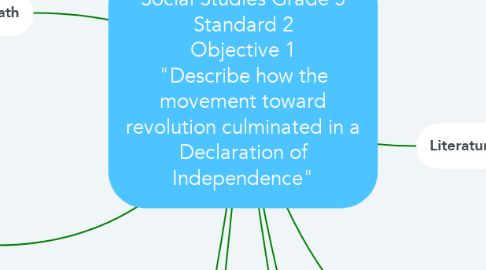Social Studies Grade 5 Standard 2 Objective 1 "Describe how the movement toward revolution culminated in a Declaration of Independence"
by Elizabeth Samann

1. Math
1.1. Students will plot on a timeline the events leading up to, during, and after the Declaration of Independence.
1.2. Students will graph the causalities of each notable battle of the Revolutionary War, noting the successes and failures of each battle. They will then use that graph to chart a scatter plot of said successes and failures.
1.3. Students will use a graphic organizer to weight the pro's and con's of staying with Britain versus fighting for freedom
2. Science
2.1. Write a Secret Letter: Students will learn how to make secret messages with invisible ink using cornstarch and iodine. Then students will learn about why different types of secret spy mail used chemical reactions back in the 1700's.
2.2. 'Revolutionary' War: Students will research about new technology and new strategies deployed by the Colonies to overcome or beat back the British. They will then discuss why these scientific advancements are important to the formation of our country.
3. Social Emotional Development
3.1. Symbols: "Explain to the students that during the Revolutionary War, the pineapple (a symbol of welcome) was often displayed at the doors of colonial homes. Discuss what symbols are, and then ask students to explore Revolutionary War sites to find additional symbols of the War or era. Then, have each student create their own personal symbol and share it with the class.
3.2. Quotes: Have students pick their favorite quotes from the Revolutionary War and then either draw a picture or write a few paragraphs on why that particular quote stuck out to them. Have them share it with the class.
3.3. Boston 'Tea' Party: Students will be asked what a 'tea' party is. Then inform them that the class will be having a tea party today! Have them pair up into groups of 2 to 4. Subtlety put on a crown. Then pass out 'money'. Inform your students that if they want to start participating in the party - they need to pay you. With increasing monetary amounts, they buy everything they need. Ask, "Is this fair?" "You need to vote for someone to come talk to me about lowering prices" When they do that... reject the person being voted. Again ask, "Is that fair?" Eventually teach about taxation without representation and how the colonists became fed up and dumped the tea into the Boston Harbor.
4. Problem Solving:
4.1. Debate: In an organized fashion, have students debate on various topics of the Revolutionary war. Should the United States have fought for Independence? Do you believe the way Loyalists were treated was right? Why or why not? Should George Washington have been our first President after the war? Who do you think should have become President instead? What was the most important event of the War, and why?
5. Fun Classroom Activity for Good Behavior:
5.1. Students will be able to watch the movie"National Treasure" if they continue to stay on task and motivated during one class period near the end of the unit.
6. Literacy and Language
6.1. Students will write in the perspective of a Patriot or Loyalist on the day to day life of colonial America - urging the reader to join their political stances using examples, especially in regard to the Declaration of Independence.
6.2. Letters from the Frontlines: Students will write 'home' to their fictional families in the format of a letter, describing the conditions and their hopes and fears about the war. They will write about the newly formed Declaration of Independence and their thoughts about it. They will then use quills and 'fountain' ink to make authentic looking letters.
6.3. Students will rewrite the Declaration of Independence in easier language, making a book for younger kids to understand. The key is to not lose any of the meaning of the Declaration while still explaining it.
7. Physical Health and Development
7.1. Paul Revere's Ride: Students will reenact Paul Revere's ride by passing along their secret messages using a relay race. Shouting "The British are Coming" is optional but encouraged. Discuss why Paul Revere's Ride was so important and has remained an iconic event in the Revolutionary War.
8. Creative Arts
8.1. "Give me liberty or give me death.": Students will research, design, and make props for their favorite moment from the Revolutionary War working in groups or pairs.
8.2. Have students listen to music from the time period. Afterwards, have them compare and contrast music from the Revolutionary War era and today's music. Then, if time allows - have them create their own 'era' music.
9. Field Trip:
9.1. Take a field trip to the State Capital and explain how the events of the Revolutionary War culminated eventually to our government as we know it.
10. Literature:
10.1. Declaration of Independence Common Sense by Thomas Paine The Secret Soldier by Ann McGovern I survived the American Revolution, 1776 by Lauren Tarshis They Called Her Molly Pitcher by Anne Rockwell Paul Revere's Ride by Henry Wadsworth Longfellow Give Me Liberty! by Russel Freedman The Declaration of Independence: The Words that Made America by Sam Fink The Journey of the One and Only Declaration of Independence by Judith St. George and Will Hillenbrand The Declaration of Independence from A to Z by Catherine Osornio and Layne Johnson


